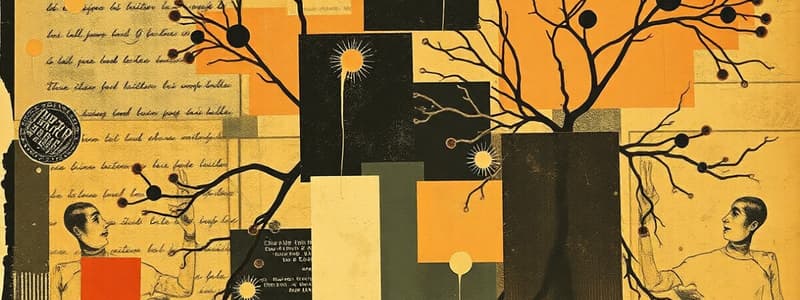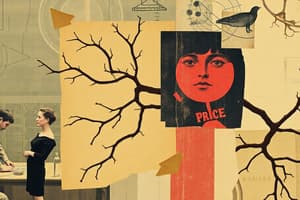Podcast
Questions and Answers
What characterizes the paralysis observed in polio?
What characterizes the paralysis observed in polio?
- It only affects respiratory muscles.
- It is asymmetrical and typically non-progressive. (correct)
- It is symmetrical and progressive.
- It results from damage to sensory neurons.
What is a common initial symptom of Myasthenia Gravis?
What is a common initial symptom of Myasthenia Gravis?
- Respiratory distress immediately
- High fevers and chills
- Asymmetrical paralysis
- Blurry vision and double vision (correct)
Which of the following statements about Botulism is accurate?
Which of the following statements about Botulism is accurate?
- It is primarily transmitted through sexual contact.
- It causes immediate sensory and motor deficits.
- It is caused by a neurotoxin that prevents the release of ACh. (correct)
- It leads to chronic, progressive muscle weakness.
What is a distinguishing feature of the Post-Polio Syndrome?
What is a distinguishing feature of the Post-Polio Syndrome?
Which of the following best describes the symptom onset for Botulism?
Which of the following best describes the symptom onset for Botulism?
What aspect of Myasthenia Gravis affects skeletal muscle efficiency?
What aspect of Myasthenia Gravis affects skeletal muscle efficiency?
Which form of paralysis is seen in polio?
Which form of paralysis is seen in polio?
What is a unique feature of Botulism compared to other forms of paralysis?
What is a unique feature of Botulism compared to other forms of paralysis?
Which statement accurately reflects the recovery process from paralytic polio?
Which statement accurately reflects the recovery process from paralytic polio?
Which of these statements about the characteristics of paralytic polio is correct?
Which of these statements about the characteristics of paralytic polio is correct?
What neurotransmitter is released by cholinergic neurons?
What neurotransmitter is released by cholinergic neurons?
Which type of receptors do adrenergic neurons primarily interact with?
Which type of receptors do adrenergic neurons primarily interact with?
Which condition is characterized by bilateral, distal limb wasting and weakness?
Which condition is characterized by bilateral, distal limb wasting and weakness?
What effect does acetylcholinesterase have on acetylcholine?
What effect does acetylcholinesterase have on acetylcholine?
Which receptor subtype is responsible for producing excitation when activated?
Which receptor subtype is responsible for producing excitation when activated?
What type of neuropathy typically occurs in a distal, bilateral, and symmetrical pattern due to diabetes?
What type of neuropathy typically occurs in a distal, bilateral, and symmetrical pattern due to diabetes?
Which of the following neurotransmitters is specifically associated with sympathetic postganglionic neurons?
Which of the following neurotransmitters is specifically associated with sympathetic postganglionic neurons?
What is a common symptom of Guillain-Barre Syndrome?
What is a common symptom of Guillain-Barre Syndrome?
What typically causes alcoholic neuropathy?
What typically causes alcoholic neuropathy?
What is the main classification of adrenergic receptors?
What is the main classification of adrenergic receptors?
In which condition do 30% of patients require mechanical ventilation due to respiratory involvement?
In which condition do 30% of patients require mechanical ventilation due to respiratory involvement?
Which receptor agonist mimics the effects of natural neurotransmitters?
Which receptor agonist mimics the effects of natural neurotransmitters?
Which type of receptors are stimulated by nicotine?
Which type of receptors are stimulated by nicotine?
Flashcards
Polio: Paralytic Form
Polio: Paralytic Form
Polio's paralytic form involves motor cell body damage, leading to asymmetrical paralysis and potential respiratory complications.
Post-Polio Syndrome
Post-Polio Syndrome
A condition affecting polio survivors decades later, characterized by new muscle symptoms like pain, atrophy, and fatigue.
Myasthenia Gravis
Myasthenia Gravis
A neuromuscular disorder causing fluctuating muscle weakness and fatigability due to autoimmune attack on ACh receptors.
Botulism
Botulism
Signup and view all the flashcards
Fecal-Oral Route (Polio)
Fecal-Oral Route (Polio)
Signup and view all the flashcards
Neuromuscular Junction (NMJ)
Neuromuscular Junction (NMJ)
Signup and view all the flashcards
Wallerian Degeneration
Wallerian Degeneration
Signup and view all the flashcards
Botulinum Toxin
Botulinum Toxin
Signup and view all the flashcards
Asymmetrical Paralysis
Asymmetrical Paralysis
Signup and view all the flashcards
Anterior Horn Cell
Anterior Horn Cell
Signup and view all the flashcards
Cholinergic neuron
Cholinergic neuron
Signup and view all the flashcards
Nicotinic receptors
Nicotinic receptors
Signup and view all the flashcards
Muscarinic receptors
Muscarinic receptors
Signup and view all the flashcards
Adrenergic neuron
Adrenergic neuron
Signup and view all the flashcards
Adrenergic receptors
Adrenergic receptors
Signup and view all the flashcards
Alpha Adrenergic receptor
Alpha Adrenergic receptor
Signup and view all the flashcards
Beta Adrenergic receptor
Beta Adrenergic receptor
Signup and view all the flashcards
Receptor agonist
Receptor agonist
Signup and view all the flashcards
Receptor antagonist
Receptor antagonist
Signup and view all the flashcards
Charcot-Marie-Tooth disease (CMT)
Charcot-Marie-Tooth disease (CMT)
Signup and view all the flashcards
Diabetic Neuropathy
Diabetic Neuropathy
Signup and view all the flashcards
Alcoholic Neuropathy
Alcoholic Neuropathy
Signup and view all the flashcards
Chronic Renal Failure Neuropathy
Chronic Renal Failure Neuropathy
Signup and view all the flashcards
Anemia Neuropathy
Anemia Neuropathy
Signup and view all the flashcards
Study Notes
Neurotransmitters and Receptors
- Receptors are integral membrane proteins in the post-synaptic cell's plasma membrane.
Cholinergic Neurons
- Release acetylcholine (ACh).
- Types of cholinergic neurons include: all preganglionic neurons, all parasympathetic postganglionic neurons, and sympathetic postganglionic neurons innervating sweat glands.
- ACh is stored in synaptic vesicles and released via exocytosis.
- Two types of cholinergic receptors:
- Nicotinic receptors:
- Located on sympathetic & parasympathetic postganglionic neurons, chromaffin cells, motor end plates, and neuromuscular junctions (NMJs).
- Stimulated by acetylcholine and nicotine.
- Muscarinic receptors:
- Located on all effectors innervated by parasympathetic postganglionic neurons, and sweat glands.
- Stimulated by acetylcholine.
- Nicotinic receptors:
Adrenergic Neurons
- Release norepinephrine (NE), also known as noradrenaline.
- Primarily found on most sympathetic postganglionic neurons.
- NE is stored in synaptic vesicles and released by exocytosis.
- Adrenergic receptors bind to both NE and epinephrine (adrenaline).
- NE can act as a neurotransmitter or a hormone released by chromaffin cells.
- Epinephrine is a hormone released by chromaffin cells.
- Adrenergic effects are typically longer lasting compared to cholinergic effects.
- NE is either reabsorbed by the axon that released it, or inactivated by enzymes (COMT and MAO).
- Two main types of adrenergic receptors:
- Alpha: further sub-classified into α1, α2 subtypes.
- Beta: further sub-classified into β1, β2, β3 subtypes.
- Alpha1 and Beta1 receptors generally produce excitation.
- Alpha2 and Beta2 receptors generally cause inhibition.
- Beta3 receptors are only found in brown adipose tissue, and their activation stimulates thermogenesis (heat production).
Receptor Agonists and Antagonists
- Agonist: A substance that binds to and activates a receptor, mimicking the effect of a natural neurotransmitter or hormone.
- Antagonist: A substance that binds to and blocks a receptor, preventing a natural neurotransmitter or hormone from exerting its effect.
Effects of Sympathetic Stimulation (vs. Parasympathetic)
- Effects are longer lasting and more widespread due to greater divergence of sympathetic postganglionic axons activating multiple tissues simultaneously.
- Acetylcholinesterase quickly inactivates ACh, while NE lingers in the synaptic cleft.
- NE and epinephrine secreted into the blood from the adrenal medullae amplify and prolong responses caused by the neurotransmitter norepinephrine.
Nervous System Diseases
- Charcot-Marie-Tooth Disease (CMT):
- Most common inherited disorder affecting motor and sensory nerves.
- Initially involves the fibular nerve leading to foot and lower leg muscle impairment, then progresses to forearms and hands.
- Characterized by:
- Bilateral distal limb wasting and weakness.
- Skeletal deformities.
- Distal sensory loss and abnormal deep tendon reflexes (DTRs).
- Diabetic Neuropathy:
- A common complication of diabetes mellitus due to long-term hyperglycemia impairing vasculature and nerve function.
- Symptoms are typically distal, bilateral, and symmetrical.
- Primarily affects sensory nerves but can affect motor or autonomic nerves.
- Alcoholic Neuropathy:
- Caused by chronic alcohol abuse, with lesions affecting peripheral nerves attributed both to the toxin's direct effect and nutritional deficiencies.
- Symptoms appear distally and symmetrically in a progressive pattern, affecting both motor and sensory nerves.
- Chronic Renal Failure:
- Peripheral neuropathy generally symmetrical, progressive, and more common in the lower extremities (sensory & motor nerve atrophy and demyelination).
- Anemia:
- Neuropathy patterns are usually distal and symmetrical, impacting motor and sensory function. Sensory loss, such as proprioception issues, can cause issues with walking.
- Guillain-Barré Syndrome (GBS):
- Most common cause of rapidly progressive evolving motor and sensory problems, often peaking within 2-3 weeks.
- Immune-mediated disorder potentially triggered by infections or vaccinations, resulting in demyelination (of Schwann cell myelin) and axonal degeneration.
- Characterized by rapidly ascending symmetrical weakness and sensory impairments. Initially appearing in the toes, weakness progresses to arms, trunk, and facial muscles.
- Recovery progresses from proximal to distal areas, and may take months or years.
- Poliomyelitis:
- A viral infection damaging motor cell bodies, leading to asymmetrical paralysis.
- Post-Polio Syndrome:
- Characterized by new muscle symptoms decades after recovering from paralytic polio, often featuring pain, muscle atrophy, and fatigue.
- Myasthenia Gravis:
- Most common disorder of neuromuscular transmission with fluctuating weakness and fatigability of skeletal muscles. Caused by auto-antibodies antagonistically binding to ACh receptors and causing their destruction.
- Botulism:
- Caused by the botulinum toxin produced by Clostridium botulinum, resulting in flaccid paralysis due to the toxin interfering with Ach release at motor endplates. Symptoms typically include malaise, weakness, blurred vision, and other gastrointestinal distress; progressing to dysphagia, dysarthria, and photophobia.
Studying That Suits You
Use AI to generate personalized quizzes and flashcards to suit your learning preferences.




